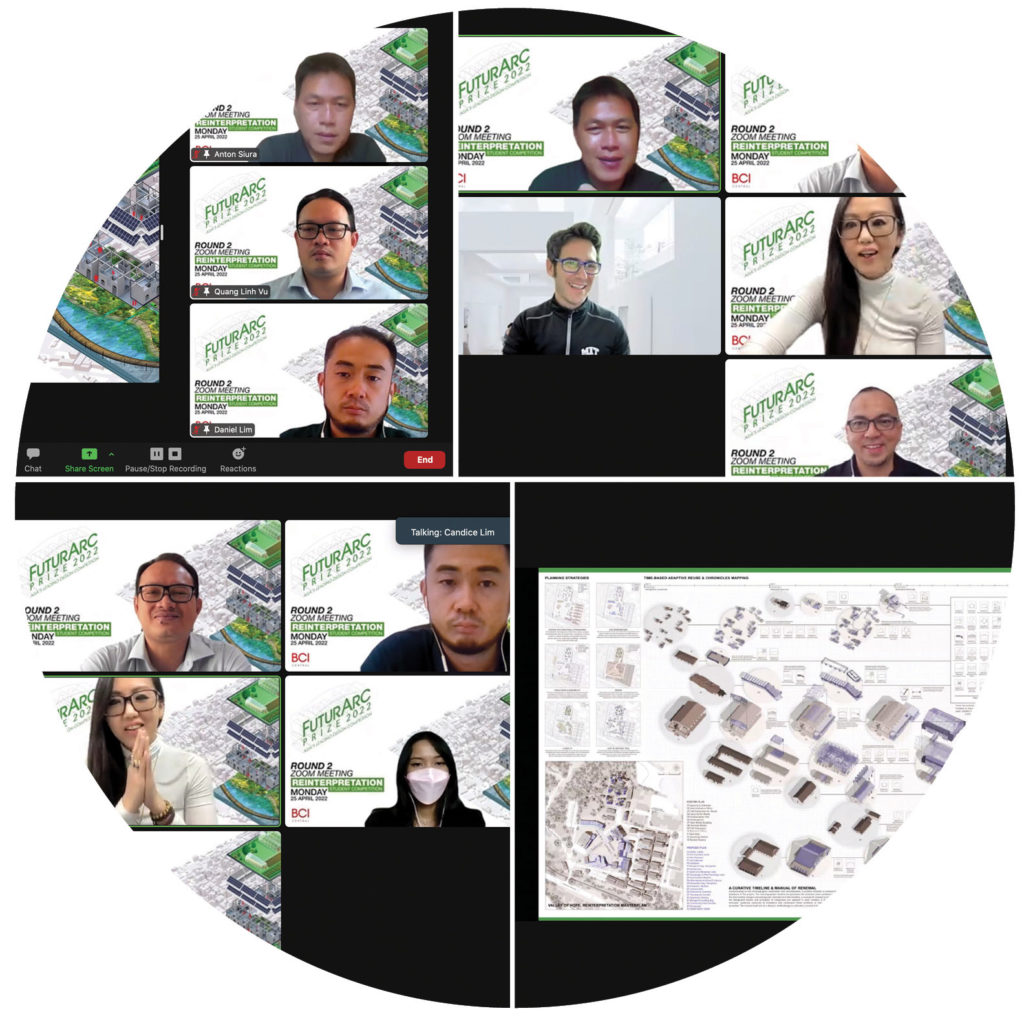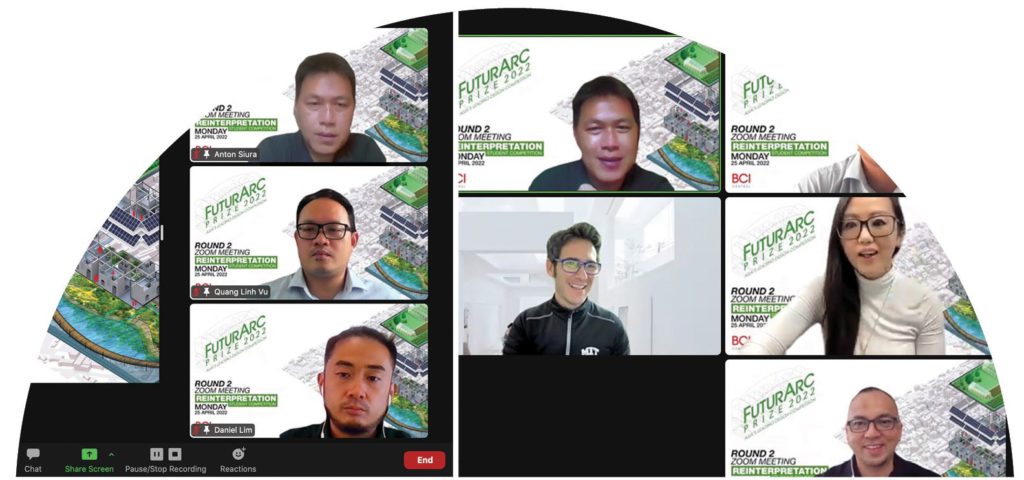Not Just Buildings: Round-Table Discussion with FuturArc Prize 2022 Jurors
September 6, 2022

FuturArc Prize (FAP) 2022: Reinterpretation asked students to reinterpret existing corporate/private/state-owned entities in Asia to transform them into civic/public spaces that give back to the community and are good, inviting, safe and sustainable.
The following is FuturArc‘s round-table session with the jurors to get their more candid comments and feedback on the competition’s theme, considering their different backgrounds, experiences, countries of practice and diverse types of projects handled.
DM: What is your opinion of the reinterpretation theme? What expectations did you have in mind of the project entries?
Let’s start with the country from which we have received the most entries in this competition, which is Vietnam. Mr Quang, what’s your opinion about this topic?
QVL: Yes, this is my first time as a juror for FuturArc Prize 2022. So, thank you again for having me. I was surprised to see a lot of entries from Vietnam. And I see that the students in Vietnam have a lot of innovative ideas, perhaps from joining FuturArc Prize previously.
In recent years, a lot of entries from Vietnam have won in this design competition. Overall, there are a lot of good entries from different countries this year, a lot of innovative ideas—ranging from very complex programmes to something that’s very simple to understand. It is very good for all of us to look at such student entries and to increase our awareness of good design, and how good design can do good for the local community.
WATCH: FuturArc Prize 2022 | Juror Interview: Quang Vu Linh
DM: Let’s now seek input from Mr Anton Siura, who hails from Indonesia, but also practises in Singapore. Indonesia is also another country that is quite popular with FuturArc Prize entrants. There are over 160 architecture schools in Indonesia. That’s a lot compared to, for example, Singapore and Malaysia. With that many architecture students in Indonesia, we have also received numerous entries, and very creative ones too.
What is your opinion on the reinterpretation theme? How much is it needed in the context of Indonesia?
AS: The topic of this competition is very interesting. And as always, FuturArc Prize topics are always very broad and impactful, encouraging people to think of different ways of looking at architecture design. The architecture that we learnt 15 years ago is different from now. Today, we look at global climate change, biodiversity, the programme’s adaptive reuse, much more deeply than just doing design or thinking about a façade, say 15, 20 years ago.
RELATED | Ragunan Bio Park: A Nature-based update of Indonesia’s oldest zoo

So, this topic definitely encourages people not to just design buildings, but to design programmes that benefit Earth and for society, nature, ecology. So, most of the schemes think that way—they don’t look at the aesthetics of the buildings; they look at what they can provide, what programmes they can do. And some of them look at a much bigger context. They look at, for example, Indonesia’s biodiversity; they don’t just design for a specific place like in Jakarta, but they also look at how to attract biodiversity. And this involves not just one field of architectural design; it involves ecologists, landscape architects, urban designers.
Now the type of work is really about multidisciplinary collaboration, and we can see some of these in this competition—the teams could consist of different kinds of professions, such as architects, landscape architects, engineers, and maybe those who are interested in social issues.
This topic definitely encourages people not to just design buildings, but to design programmes that benefit Earth and for society, nature, ecology.
DM: On the note of the programmes and the importance of end users, Mr Daniel Lim, you work with communities directly for their input on the betterment of the environment, etc. So, what is actually the first thing that we should take into account when we talk to people on the ground about reinterpretation projects?
DL: Coming from an urban regeneration organisation, yes, it is important for placemaking to go through a process. And the process is not just about engaging with the community, but also about doing some form of cultural mapping and implementing evidence-based approaches. So, at the technical level, we look at it from a data-driven angle, we look at spatial intelligence, etc.
RELATED: Daniel Lim on People & Placemaking
On the ground level, we do cultural mapping to understand how the community uses the space, its cultural and heritage significance, etc. And then, lastly, is the new use that’s going to be introduced—how people are going to respond or react to it, which also translates to a sense of ownership. So, the key here is to find a balance for all these three components and put it out there before we even go into design stage.

At the technical level, we look at it from a data-driven angle, we look at spatial intelligence.
DM: I now want to ask Mr Carlos Bañón, since you have practised in both countries, about the differences between Singapore and Spain that you have observed. How do you feel reinterpretation has been dealt with by the entrants of this competition, considering your background?
CB: Yes, there’re many differences between both contexts. I came from Spain where I practiced for 20 years. I think we shifted from new buildings when sustainability was yet to be developed, and so, we started doing many competitions to design new buildings from scratch. Now, it has reverted to following what we have, and trying to change the use and create opportunities.
RELATED | Carlos Bañón’s award-winning AirMesh
In Singapore, the context is different; we have scarcity of land, so we go vertical. There is also the need to fulfil with architecture the goals for 2030 in food security, in addressing waste, in reduction of resources, in irrigation methods, etc. Here, those things are more accentuated. Also, Singapore is quite driven by innovation. So typically, our students and the kind of the proposals they do try to target those problems and integrate them into vertical developments.
[This is an excerpt. Subscribe to the digital edition or hardcopy to read the complete article.]
RELATED: Practicality or Concept: Excerpts from FuturArc Prize 2022 Jury Meeting

RELATED: What our jurors say about FuturArc Prize 2022 Entries

Read more stories from FuturArc 3Q 2022 Green Awards: Reinterpretation!

To read the complete article, get your hardcopy at our online shop/newsstands/major bookstores; subscribe to FuturArc or download the FuturArc App to read the issues!
Previously Published In Conversation
Contact us at https://www.futurarc.com/contact-us for older interviews.

